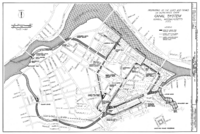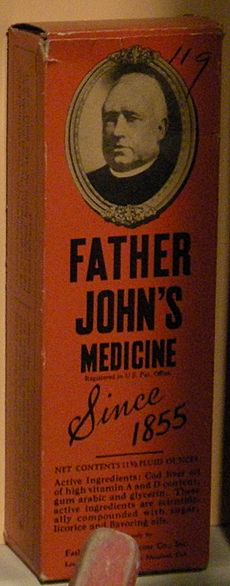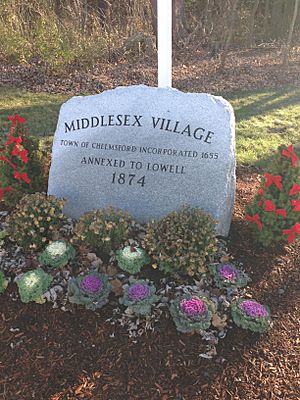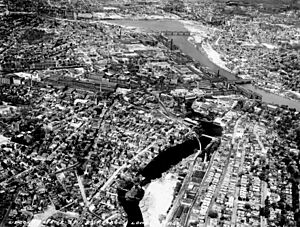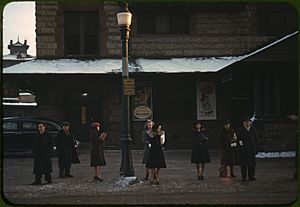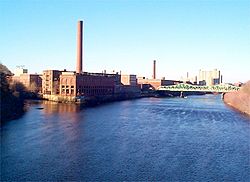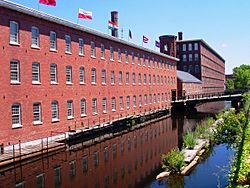History of Lowell, Massachusetts facts for kids
The history of Lowell, Massachusetts, is closely connected to its location by the Pawtucket Falls of the Merrimack River. This area was once an important fishing spot for the Pennacook tribe. Later, the powerful waterfalls provided water power for the factories that became the heart of the city's economy for about 100 years.
The city of Lowell was started in the 1820s. It was a project called "The Lowell Experiment" that aimed to make money and create a new kind of community. Lowell quickly became the biggest textile (cloth-making) center in the United States. However, about a century later, the textile industry in New England declined and collapsed. This caused a difficult time for the city.
Lowell's "rebirth" (or comeback), partly helped by the Lowell National Historical Park, has made it a good example for other old factory towns. Lowell is known as the "Cradle of the American Industrial Revolution" because it was the first large-scale factory town in the United States.
Contents
Lowell's Early Days and Native Americans
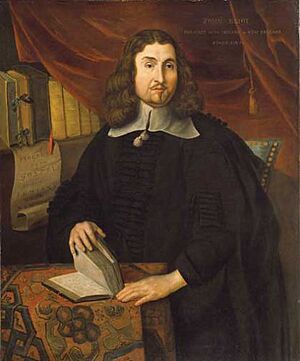
The land where Lowell is today was a very important place for the Pennacook Native American tribes. The Pawtucket group lived on the northern side of the Pawtucket Falls on the Merrimack River. The Wamesits lived along both sides of the Concord River.
The area of Lowell was the main meeting place for both the Pawtucket and Wamesit tribes. This was because they could easily catch salmon at Pawtucket Falls. The local rivers also provided a great way to travel. When European colonists first met these tribes, it was believed that about 12,000 people lived there, with 3,000 in the main village.
First Meetings with Colonists
The first interactions between the colonists and the Pawtucket tribe involved trading and sharing religious beliefs. In the 1640s, Major Simon Willard traded a lot with the tribes. In 1647, a famous preacher named John Eliot joined him. Eliot returned a year later and soon started a church there. A Native American convert named Samuel became the pastor.
A church building was built in 1653 and stood until 1824. Colonists began to move closer to the native tribes when Chelmsford was founded in 1653. More land was given out, covering most of what is now Lowell. However, 500 acres of farmland were kept for the Pawtucket tribe.
The colonists started buying land from the Pawtucket. They traded the 500 acres for an island called Wickassee, which was above the Pawtucket Falls. A war called King Philip's War caused a lot of fear. It also weakened the tribe and made their relationship with the colonists worse.
Changes After the War
By the end of the war in 1676, the Native American community was much smaller. Wannalancit, the son of the Pawtucket leader, took the remaining tribesmen to Wickassee. He later sold the land in 1686. The tribe then moved to Canada. They traveled with the Abenaki tribe before briefly returning in 1692. They came back to talk with other tribes for Chelmsford during King William's War.
The last parts of Pawtucket land were bought in the early 1700s. A legal document in 1714 removed their last claim to the land. In 1726, "Indian town" was officially added to the colonial areas. After this, what is now Lowell became fully owned by colonists. It was part of the towns of Chelmsford and Dracut.
Lowell's Start as a Factory Town

Business people soon saw Chelmsford as a good place for new mills and factories. The Pawtucket Falls offered a strong source of water power. This led to the building of a sawmill and a gristmill (for grinding grain) in the early 1700s. A fulling mill (for cleaning cloth) followed in 1737.
The many forests in the region made it good for logging. But there needed to be a way to ship lumber down the river. The Pawtucket Falls, with their 32-foot drop, made this difficult. In 1792, a group called the Proprietors of Locks and Canals was formed. They finished building a canal to go around Pawtucket Falls in 1797. This canal allowed lumber and other products to be shipped to Newburyport.
However, another canal, the Middlesex Canal, was built. This canal created a direct route to Boston. It greatly hurt the Pawtucket Canal's chances, and it quickly stopped being used.
The Birth of Lowell's Mills
Francis Cabot Lowell was an American businessman who dealt with textiles. In 1810, he visited Britain to study their textile machines. British law did not allow these machines to be taken out of the country. So, Lowell memorized the designs. When he returned, he helped build a copy of the machines.
In 1813, he started the Boston Manufacturing Company and built a cotton mill in Waltham, Massachusetts. This mill was the first in America to use power looms (machines that weave cloth using power). It was so successful that Patrick Jackson, who took over after Lowell died in 1817, saw a need for a new factory. Waltham had been chosen for its power from the Charles River. Jackson decided to use Pawtucket Falls to power the second factory.
The canal, even though it wasn't used for shipping, provided a good source of water for manufacturing. Small cotton and gunpowder factories started using the canal for water power.
Jackson and others started the Merrimack Manufacturing Company to open a mill by Pawtucket Falls. They began building in 1822 and finished their first cotton run in 1823. Within two years, more mills and machines were needed. New canals were dug, allowing for even more factories.
With a growing population and a strong economy, Lowell officially separated from Chelmsford. It was named after Francis Cabot Lowell. On March 1, 1826, Lowell was officially recognized as a town with 2,500 people. In just ten years, the population grew from 2,500 to 18,000. On April 1, 1836, the town of Lowell officially became a city. This was approved by the Massachusetts General Court.
Lowell Becomes a Major City
Lowell was only the third community in Massachusetts to become a city, after Boston and Salem. At that time, Lowell had 17,633 people. Soon, the city built a court, a jail, a hospital, a cemetery, a library, and two public parks. The first museums and theaters opened around 1840.
Lowell also began adding nearby areas. It took Belvidere from Tewksbury in 1834. In 1851, Centralville was added from Dracut. Daniel Ayer started a new area called Ayer's City in South Lowell in 1847. In 1874, Pawtucketville and Middlesex Village were added from Dracut and Chelmsford. This brought the city close to its current size.
Lowell's Industrial Powerhouse
By 1850, Lowell's population was 33,000. This made it the second-largest city in Massachusetts and America's biggest industrial center. The 5.6-mile-long canal system produced 10,000 horsepower. This power was used by ten companies with a total of forty mills. Ten thousand workers used 10,000 looms and 320,000 spindles (parts of spinning machines). The mills were making 50,000 miles of cloth every year!
Other businesses also grew in Lowell. The Lowell Machine Shop and Father John's Medicine opened. Tanneries (places that make leather), a bleachery (for whitening cloth), and service companies needed by the growing city were also started. Moxie, an early soft drink, was invented in Lowell in the 1870s. Around 1880, Lowell became the first city in America to have telephone numbers.
Lowell continued to be a leader in new industrial technology. In 1828, Paul Moody created an early belt-driven power system. This was much better than the old, unreliable gears used at the time. In 1830, Patrick Tracy Jackson ordered work on the Boston and Lowell Railroad. This was one of the Oldest railroads in North America. It opened five years later, making the Middlesex Canal no longer needed. Soon, train lines went up the Merrimack to Nashua, downriver to Lawrence, and inland to Groton Junction, now known as Ayer. Ayer was renamed after Dr. James Cook Ayer, a wealthy Lowell businessman who made patent medicines.
Uriah A. Boyden put his first turbine (a machine that uses water to create power) in the Appleton Mill in 1844. This was a big improvement in efficiency over old-fashioned waterwheels. The turbine was made even better in Lowell by an Englishman named James B. Francis. He was the chief engineer of the Proprietors of Locks and Canals. Francis had started his career working under George Washington Whistler, who was the father of the famous painter James Abbott McNeill Whistler. Francis's improved turbine, called the Francis Turbine, is still used today with only a few changes.
Francis also designed the Francis Gate. This was a flood control system that could seal off the canal system from the Merrimack River. He also finished the canal system by adding the Northern Canal and Moody Street Feeder. Both of these were designed to make the whole system work better. To get more water power all year round, Francis and engineers from Lawrence worked with The Lake Company. This company built dams in the Lakes Region of Central New Hampshire. These dams, built in the mid-1800s, allowed cities on the Merrimack River to store and release water from the Merrimack's source, including Lake Winnipesaukee.
Modern Changes in Lowell
In the late 1800s, new technologies changed Lowell. Electric streetcars allowed the city to grow, creating new neighborhoods on the edges. Tyler Park and Lynde Hill in Belvidere became home to many of Lowell's richest people. They could now live away from the noisy and polluted downtown factory area.
The wealthy city built a huge new city hall in the Romanesque style. It was made of granite and had a clock tower that could be seen from the mill yards. A new library with a hall for the Civil War, a post office, and fancy commercial buildings replaced the older, simpler structures.
Steam power was first used in Lowell in the 1860s to add to the water power. By the mid-1870s, steam was the main energy source. Electricity allowed the mills to run on hydroelectricity (power from water), instead of direct water power. These improvements helped Lowell keep increasing its factory output without needing many more workers.
However, moving away from pure water power meant that Lowell was being passed by other cities. These cities had better locations for the new power sources. For example, in the 50 years after the Civil War, Fall River, Massachusetts and New Bedford, Massachusetts became larger factory towns than Lowell in terms of what they produced. This was mainly because their locations by the sea made it cheaper to bring in and send out goods and materials, especially coal. Lowell was far inland and could only be reached by train. By 1920, people were even suggesting that the Merrimack River be dug deeper from Newburyport to Lowell so that barges could reach the city. But events in the 1920s stopped that from happening.
In 1885, the Lowell Co-operative Bank was founded. Today, it is called Sage Bank, and it is one of the oldest banks still operating in Massachusetts.
Immigration to Lowell
Lowell was a growing city with many jobs that didn't require special skills. Because of this, many immigrants came to Lowell to work in the mills. The first 30 Irish workers came to help build the canals. They were led by Hugh Cummiskey and walked along the Middlesex canal from Charlestown to Pawtucket Falls on April 6, 1822. They were met by Kirk Boott and given very little pay. No housing or other supplies were provided for them.
More Irish immigrants came after the Great Famine of Ireland. Later, Catholic Germans also arrived. These Irish immigrants were directed to land not controlled by the mills, in an area now called "The Acre." Sometimes, mill companies would try to cause problems between different groups of workers. In the 1840s, an anti-immigrant and anti-Catholic group called the American Party (also known as the Know-Nothing Party) won elections in Lowell.
By the 1850s, there was more competition from other factory towns. Lowell's mills began to hire more immigrant families. The early "Lowell System," where young American women lived in company housing, changed. Instead, large, crowded neighborhoods grew around the city. The people living there felt more connected to their churches, groups, and communities than the earlier mill workers.
Lowell During the Civil War
The American Civil War caused many mills to close temporarily. They sold off their cotton supplies, which became more valuable than finished cloth after imports from the South stopped. Many jobs were lost. However, the impact was lessened because many men were serving in the military.
Lowell played a small but important role in the war. Many wool uniforms for the Union army were made in Lowell. General Benjamin Franklin Butler was from the city. Members of the Lowell-based Massachusetts Sixth Regiment were the first four Union soldiers to die. They were killed in a riot while passing through Baltimore on their way to Washington, D.C. Three of these soldiers are buried in front of City Hall under a large obelisk (a tall, pointed stone monument).
After the war, the mills started working again. Recruiters looked all over New England for new workers. Many new mill workers were widows or single mothers. By August 1865, this source of workers ran out.
New Waves of Immigrants
New groups of immigrants moved into the city. In the 1870s and 1880s, French Canadians began moving into an area that became known as Little Canada. Later French Canadian immigrants included the parents of the famous writer Jack Kerouac, who was born in Lowell.
At the end of the 1800s and beginning of the 1900s, Greeks moved into parts of the old Irish Acre. Other groups like the Portuguese, Polish, Lithuanians, Jews, Swedes, Finns, and Norwegians also came to work in Lowell. They settled in their own neighborhoods throughout the city. In the late 19th and early 20th centuries, about half of Lowell's 112,000 residents were born in other countries.
Lowell's Decline
By the 1920s, the textile industry in New England began to move South. Many of Lowell's textile mills started to move or close. Even though the South didn't have rivers with enough water power for the early mills, new steam-powered factories allowed companies to take advantage of cheaper labor and lower transportation costs there.
Worker strikes in the North became more common. Big strikes, like the 1912 Bread and Roses Strike in nearby Lawrence, increased costs for investors. Many textile companies decided to stop investing in their mills. They would run the mills without making any improvements until they could no longer make a profit. This profit was then used to build or improve new factories elsewhere.
In 1916, the Bigelow Carpet Company, which had bought the Lowell Manufacturing Company, left Lowell. This was the first major company to move its operations South or go out of business. World War I briefly made things better. But from 1926 to 1929, most of the remaining companies, including the Lowell Machine Shop, left the city. The Great Depression arrived early in Lowell.
In 1930, Lowell's population was just over 100,000, down from a high of 112,000 ten years earlier. The textile industry employed 8,000 people in 1936, down from 17,000 in 1900. By the start of World War II, 40% of the city's population needed public assistance. World War II again briefly helped the economy. Demand for clothing went up, and Lowell was involved in making weapons. After the war, things slowed down again. In 1956, the Boott Mills closed. In 1958, after more than 130 years, the Merrimack Manufacturing Company closed.
Lowell's Lowest Point
By the mid-1970s, Lowell's population had dropped to 91,000. Twelve percent of its residents were unemployed. The city's industrial economy was mostly made up of many small, struggling businesses. The city's buildings and roads were often over a hundred years old, outdated, and falling apart. Many were empty and taken by banks.
A process called Urban renewal involved tearing down many old buildings. This was a desperate attempt to improve Lowell. In 1939, the Greek Acre was the first area in the country to have "slum clearance" using money from the government. This meant old, run-down buildings were removed to make way for new development. In the late 1950s, Little Canada was also torn down. In 1960, the Merrimack Manufacturing Company's mill yard and housing were removed to build warehouses and public housing. Other neighborhoods were also cleared. Fires became a serious problem, and crime increased. Lowell's reputation suffered greatly.
As cars became more popular after World War II, downtown Lowell faced problems. People had less money to spend, and businesses moved to shopping malls in the suburbs. Theaters and department stores left. Much smaller businesses moved in, if any. Many buildings were torn down for parking lots, and others burned down and were not replaced. Some buildings had their top floors removed to lower tax bills. Many building fronts were "modernized," which destroyed their old Victorian look. Road widening and other improvements destroyed a row of businesses next to city hall. The construction of the Lowell Connector highway around 1960 was not very disruptive for a city highway. This was because plans to extend it further were canceled. People even started talking about filling in the canals to create more land for building.
Officials described the city as looking like Europe after World War II. However, the destruction and decay of much of what made Lowell a lively city led some residents to think about saving the historical buildings.
Lowell National Park and Comeback
Even as far back as the 1860s, a local historian named Charles Cowley described Lowell as a city with little community pride. At the time, Cowley thought this was because a large part of the population was born in other countries and didn't have strong ties to the city. After its factories collapsed, this feeling grew, even if the reasons changed. Many Lowell residents viewed the city's industrial past negatively. They felt the factories had abandoned their workers and now stood empty and broken.
However, some city residents, like educator Patrick J. Mogan, believed that the city's history should be saved and used to help the city. In 1974, Lowell Heritage State Park was founded. In 1978, the Lowell National Historical Park was created as a national park within a city. This happened because of a law proposed by Lowell native, congressman, and later senator Paul Tsongas. The canal system, many mills, and some downtown commercial buildings were saved by the park's creation and the visitors it brought.
The "Massachusetts Miracle" brought new jobs and money to the city in the 1980s. Wang Laboratories became a major employer and built its world headquarters on the edge of the city. After the Vietnam War and the Khmer Rouge rule of Cambodia, many people from Southeast Asia, especially Cambodians, moved into the city. Lowell became the largest Cambodian community on the East Coast and the second largest in the country after Long Beach, California.
Combined with other immigrant groups like Puerto Ricans, Greeks, and French Canadians, these newcomers brought the city's population back up to over 100,000. However, this good time didn't last long. By 1990, the Massachusetts Miracle was over. Wang Laboratories almost disappeared, and even more of Lowell's long-standing businesses failed. Around this time, the last large department store left downtown Lowell. This was largely blamed on suburban factors, including a large mall built nearby in tax-free New Hampshire in the mid-1980s, followed by another large mall, also in New Hampshire, in the early 1990s.
Lowell in the Modern Era
Besides the National Historical Park, Lowell is a working modern city with over 100,000 residents. Many efforts have been made over the last fifteen years to change the city's focus away from manufacturing. The goal is to move towards a post-industrial economy, which means focusing on services and technology instead of just factories.
Community Growth
New groups have moved into Lowell's neighborhoods, including Brazilians and Africans. This continues Lowell's traditional role as a melting pot, where many different cultures come together.
A project to redevelop land once used by the Saco-Lowell Shops and the Hamilton and Appleton Mills was started in 2009. Many projects are happening around the city to make decaying areas more beautiful and useful again.
Fun and Tourism
The Tsongas Center at UMass Lowell and LeLacheur Park were built in 1998. Hockey teams like the Lowell Devils and baseball teams like the Lowell Spinners came to the city. Big national shows and concerts are performed at the arena and at the old Lowell Memorial Auditorium. The Lowell Folk Festival, which is the largest free folk festival in the country, is an event that happens every year.
The National Park has continued to grow. Many buildings are still being fixed up and made new again.
After Massachusetts started offering a tax credit for movies filmed in the state, a few movies have been made in Lowell. The Invention of Lying was released in September 2009. Shortly before that, filming for The Fighter was completed. This movie is about Lowell boxing legend Micky Ward and his older brother Dicky Eklund.
Education in Lowell
The University of Massachusetts Lowell and Middlesex Community College are playing bigger and bigger roles in the city. In 2009, UMass Lowell bought the Doubletree hotel, which wasn't being used much. They turned it into a dormitory, increasing their presence in the city's downtown area.
Images for kids


